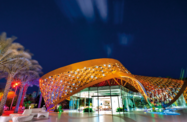Tourism officials in Sharjah have adopted a hard-sell approach to promoting the emirate’s credentials as a travel destination, racking up frequent flyer points of their own as they criss-cross the globe to take part in tourism fairs and trade events. The success of this campaign will depend to some degree on the health of the economies of the countries targeted by the emirate’s promotional push.
More than 1.55m foreign tourists visited the emirate last year, an 8% increase on the 2009 performance, according to data issued by the Sharjah Commerce and Tourism Development Authority (SCTDA). Of these, 42% came from Europe, with a further 24% originating from neighbouring GCC states, 17% from Asia and another 12% from Arab states beyond the Gulf region. Overall, tourism receipts contribute more than 11% of GDP, making it one of the largest single sectors in the emirate’s economy.
Tourism’s contribution to the economy appears set to strengthen further, with a report released by SCTDA in early June showing both tourist arrivals and hotel occupancy rates posting double-digit growth for April, the former up by 11% and the latter jumping by 23% compared to the same month in 2010.
Much of this success can be attributed to the fast-paced promotion activities conducted by SCDTA and supported by other agencies such as the Sharjah Investment and Development Authority (Shurooq). While Sharjah has a good mix of tourism attractions – blending sun and sand with culture, outdoor pursuits and a burgeoning business component spearheaded by strong meetings, incentives, conferences and exhibitions (MICE) infrastructure – the emirate has to carve out a place for itself in an already crowded regional and international market.
SCTDA’s latest foreign exposure was in mid-June, when it took part in the Beijing International Tourism Expo (BITE), one of the region’s largest travel fairs. It was the sixth time that Sharjah has been represented at the expo, and this persistence appears to be paying dividends, with 2010 seeing a 248% jump in the number of Chinese visitors hosted over the previous year. While the 28,600 arrivals from China only represents a small slice of the overall tourist inflow, and indeed is only a fraction of the 228,000 inbound visitors from Asia last year, itself a 25% increase over 2009, it is clear that from having almost no presence in the Asian market just a matter of years ago, Sharjah is rapidly establishing its brand in the region.
According to Mohamed Al Noman, the director-general of SCTDA, estimates suggest that the number of Chinese nationals who will travel overseas for holidays each year will top the 100m mark by 2020, making it one of the most important global markets.
“Our participation in BITE is in line with our commercial and tourism marketing strategy and is aimed at coping with the requirements and demands of the tourism sector,” he said on June 13. “We are looking forward to the opening of the massive Chinese tourism market, which would help us attract more tourists into the emirate.”
The Chinese expo is just the latest in a long line of events that SCTDA has taken part in, with Sharjah represented at fairs in Dubai, Abu Dhabi, Berlin, Spain, the UK and the US in recent months.
While Sharjah may have been hitting targets, it can be another matter to score goals, with economic and political instability in some of its key markets having the potential to undermine some of the good work done by SCTDA and other bodies. The increasing uncertainty over the economy in the euro zone – which is being pressured by threat of a Greek default – and uncertainty and unrest across much of the Middle East and North Africa could see a downturn in holiday travel from those regions.
The benefits of Sharjah casting its promotional net further afield should help offset any dip in arrivals from the West, with a reorientation to the booming Asian market likely to make up any shortfall.

